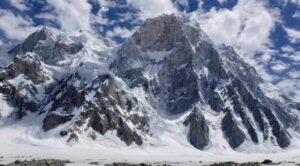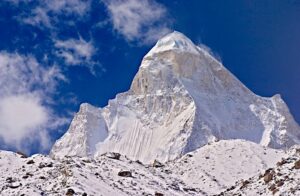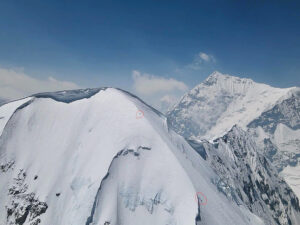In a season with plenty of bad news and criticism, with mainstream media bemoaning the stupidity of most climbers, Czech climbers Marek Holecek and Zdenek Hak brought a rare bit of alpine good news, with a bold new route up Nepal’s 7,319m Chamlang.
Faithful to alpine style standards, the project featured a minimalistic approach, an acclimatization climb well away from their main goal and a single push on a face they had spotted the previous year. Their plan was simple: pitch a tent on that “beautiful, quiet place without people, surrounded by the white ridges of wild mountains,” as Holecek put it. Thus encamped, they would wait patiently for a weather window of at least three days.

Marek Holecek in Base Camp.
On May 16, in good weather, the climbers moved to the foot of the wall, carrying a bivy tent, 80m of 7mm rope, 6 ice screws, 5 bolts, 5 Friends, food for five days and three fuel canisters. “We didn’t forget to put a pinch of good luck in our backpacks too,” Holecek joked.
But the beginning of the route was no joke. Unpleasant mixed climbing on poor rock and sugar snow forced them to fight for every inch. “If we keep progressing at this pace, we’ll reach the top in about a month,” Holecek recalled thinking.
On the second day, they hurried past a threatening serac, then progressed up steep sections to a ledge, on which they set their second bivouac. On the third day, they crossed the point of no return: a 700m climb on iced organ tubes to the upper rock band. “No sensible way back existed,” Holecek explained later.
The weather needed to be perfect, because snowfall would trigger avalanches down that exposed section, and hot days would send rocks cannonading down onto their heads.
“The possibilities of protection on those pitches was, to point it kindly, rather modest,” Holecek said. By the end of the day, it was snowing and they had no place for their third bivouac. They melted snow and masked the funny aftertaste of granite flakes with some juice powder. They failed to find a comfortable position in the tiny, “half-butt” space. “The night was hell,” said Holeček.
“The fourth morning we were really moving,” he recalled. “The very first metres went over rock filled with old ice, hard enough for the ice axes to stick.” Then came more 70º steep ice. By the afternoon, the climbers reached a “sharp ridge that offered us an extraordinary view of the world on the other side.”

On the third day, they passed the point of no return. Photo: Marek Holecek
It was windy and increasingly cold. Holecek said:
The following morning, they followed the ridge past a number of possible summits until it definitely sank down. Himalayan giants surrounded them. Holecek again waxed poetic at the sight:
“Magical vistas were opening on all sides: Kanchenjunga waved at us from the east, the Pyramid of Makalu grinning in the north. To the west, the Lhotse Wall and Nuptse’s peaks rose. And above all, Mount Everest, the roof of the world, was awake. In the distance, we also saw Cho Oyu with Giachunkang and Lantang. The spawn was Pumori, Ama Dablam, Kantenga, etc.”
They reached the main summit at 10am, in bitter cold and wind. They stopped only to shoot some pics in frozen smile poses. “It’s the glory and misery, a success without ovation,” said Holecek. “The real joy awaits down below, where we no longer have to climb.”
This joy was not as close as they would have wished. The way back along the ridge was endless, and the thick fog and blowing snow worsened. They barely made it back to their tent. They were covered in frost, soaked, exhausted and with only two chocolate bars left. The following day, they continued to hurry back down to the glacier but they couldn’t avoid a sixth bivouac, under a menacing serac, with no food and virtually no rest.

Rappeling in thick fog. Photo: Marek Holecek
The seventh day was an escape back to life. Said Holecek:
“In the morning, we did a few last rappels and had a few hours of walking on the moraine. Done! Finally, we stepped into the meadow again. After 160 hours, we escaped from the clutches of the fierce mountain. The sun leaned against our faces. The cold remained behind. We tore off our clothes and just lay in the scented grass in our underwear.”
Now back in the Czech Republic, rested from their struggle but still remembering it all too well, the climbers came up with a new rating for the challenge: ABO — French for “Abominablement difficile”. They named the new route UFOline, “to commemorate the ascent of the north wall of Chamlang, where Reinhold Messner and Doug Scott supposedly saw UFOs somewhere.”
Czech readers can view their full report here.
Below, several photos from their climb:










Related stories:
The Quiet Himalaya: A New Route on Chamlang






